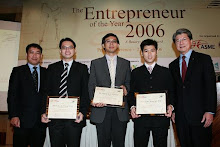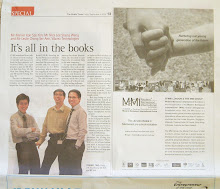I particularly like the definition of this strategy which is described by W.Chan Kim and Renee Mauborgne, Professors in strategy and international management at the INSEAD business school. http://www.blueoceanstrategy.com
Continuous competition in a market will lead to price war and oversupply of commoditized products. Brand loyalty will start to decline and profits start shrinking, ending in a bloodbath which is termed as Red Ocean.
The Blue Ocean is a market space which is untested and uncontested. Players trapped in the Red Ocean should seek a path to exit towards the Blue Ocean.
There are four principles in the Blue Ocean strategy:
1. Reconstruct market boundaries
This is to look out for spaces where current competition does not see. You may still be in the same trade, but if you manage to create a new need for people, You will see demand naturally increase. Take the example of the Japanese hairdresser franchise QB House. In the haircut industry, there are different level target markets. Budget conscious men would go for an economical haircut at the barber. More image conscious individuals would go for average class saloon. Other individuals would not even blink an eye on the high price they pay at an upclass hair saloon. QB House ingeniously created a haircut service which fuses between barber and hair saloon. It created a concept with the budget conscious individuals in mind, to provide a hair saloon quality hairstyle at a barbershop price. It revolutionize the idea of haircut and create a new need, thus found itself in the midst of the Blue Ocean where there is no existing similar provider. Although over time, it may see more copycats coming into the sector, it is important to have the first mover advantage. When it sees its Blue Ocean slowly becoming red over time, it must then seek again for the next Blue Ocean. This is what we term as constant Innovation.
2. Focus on the big picture, not the numbers:
The lifeline of a business is always its bottom line revenue and profits. However, business owners must not be led by the nose in its budget. They have to look beyond the current scenario and paint a bigger picture for the business. This usually involves time and more investments into uncharted areas and most people easily shrug off such ideas.
3. Reach beyond existing demand:
Tata Group launched the world's cheapest car, Nano, on 26 Feb 2009, just one year after acquiring two luxurious automobile brands, Jaguar and Land Rover from Ford Motors at a price tag of US$2.3 Billion. The acquisition allows Tata an immediate access to the premium market of the automobile industry. However, it was not sitting still. It had been eyeing on the untapped middle class families in India, typically seen riding precariously on two wheelers, with children. With more than 100 million of such families in India alone, pricing the Nano at a mere US$2200, it is a sure hit in this sector.
Another great revolutionary product is the Wii TV console game player, launched by Nintendo. For many years, Nintendo has been in a distant far in the lucrative game console market, from Sony's PlayStation and Microsoft's XBox. Nintendo tweaked the idea on gaming by simplifying its console that could entice both young and old in the family to play.
4. Get the strategic sequence right:
In all aspects when seeking for the Blue Ocean, you must be pragmatic. You may be just building castles in the air if certain principles are not adhered to.
- Buyer utility: Is there an exceptional buyer utility in your business idea?
- Price: Is your price practical in the market? You have to ask yourself why your customer would want to pay you that amount you have defined for your product. Existing competitors and substitutes must be also be compared with.
- Cost: Is your cost of production able to meet the expected profit margin?
- Adoption: Why would people want to adopt your new idea? Humans tend to have the comfort-zone intuition. It is not easy to persuade people to change their habits to adopt a new style. This may be the biggest hurdle amongst the four. Awareness and education may be necessary to assure customers.
Thursday, November 11, 2010
Subscribe to:
Posts (Atom)


